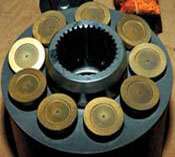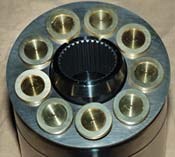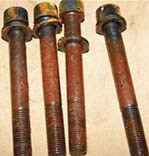12 Ways to Reduce Water Consumption
Save water, save money in your cleaning processes with these common-sense tips
A good cleaning process can minimize costs and add value to your product. With a bit of observation and planning, a well-designed industrial or critical cleaning process can reduce water consumption as well.
The most compelling reason to minimize water usage in cleaning is to control the cleaning and manufacturing process. Effective water management yields immediate benefits, including decreased operational costs; longer process bath life; better process control, including the washing, rinsing, and drying steps; lower waste stream management costs; and improved product quality.
Featured Content
1. Preclean
To save water during final cleaning, pay attention to the initial processes. Soil that has been left on the part is very adherent. Time and again, we observe the benefits of precleaning—notably, a shortened final cleaning cycle.
Precleaning also tends to decrease overall manufacturing time and rework as well as decreasing water usage. Make the initial cleaning convenient and effective, or your assemblers will simply ignore the precleaning step and pass the problem forward.
2. Choose the Right Cleaning Agent
Select the correct cleaning agent for your application, and coordinate that selection with the right cleaning system. Selecting a “default” cleaning agent and choosing a cleaning system out of a catalog is often not the most cost-effective way to go. Many critical cleaning processes have a very narrow window. If you are even a little off the mark in choosing the cleaning agent, you will end up wasting far more water than you ought to.
Understand the mix of soils, the materials of construction, the product configuration, and the expected end use of the product. Soils may be dissolved or suspended, or they may react with the cleaning agent. Soils may be organic, or they may be inorganic salts or metals. Even water-soluble or synthetic lubricants typically contain organic compounds. Some soils are particulate; the size and nature of the particles may determine the strategy for removal.
Select a cleaning agent that can be regenerated using oil separation and filtration, and that has a high soil loading for the soils of interest. It is often instructive to do pilot testing, because soil loading studies do not necessarily indicate actual cleaning efficiency.
3. Choose the Right Cleaning System
In-line, spray-in-air systems are often considered the only efficient design for high-volume cleaning. However, spray-in-air is inherently a line-of-sight process. For complex parts, spray pattern, force and direction must be fastidiously controlled; if not, cleaning will be inefficient and ineffective. Ineffective cleaning often necessitates re-cleaning. This means lost water, lost time, and higher process costs, not to mention lower product quality.
Consider batch systems with the option for turbulation, spray under immersion, and ultrasonics. For very complex workpieces, selecting an effective cleaning force means more rapid cleaning, sometimes at lower temperature.
In comparing cleaning systems, consider the impact of evaporation. Spraying the cleaning and/or rinsing agent produces a high surface area that, along with heating, contributes to evaporation. Where spray-in-air is used, the cleaning system should be designed to minimize losses through evaporation.
4. Optimize Cleaning Steps
The basic cleaning process consists of washing, rinsing, and drying. In the wash step, selecting a sub-optimal cleaning agent or failing to control the washing bath effectively wastes water directly and indirectly. One example of a direct effect is shortened bath life; every time you change the bath, you lose significant amounts of water.
An indirect effect is excessive water needed in longer rinse steps, either to remove cleaning agent residue or to achieve better removal of lubricants and related process materials in the rinse step rather than the wash step. Lack of attention to drying means recontamination of the part and spotting, often resulting in the need to reclean; with each cleaning cycle, some water is used.
5. Recover Wash and Rinse Chemistries
Generally, oil-splitting chemistries are used in industrial cleaning agents. Oil can be skimmed off the top of the cleaning solution, minimizing soil loading and extending cleaning agent life. With dip or immersion tanks, this means that oil must be constantly removed from the top with a sparger or weir to avoid recontaminating the product when it is removed from the tank. With in-line spray systems, oil removal from the cleaning agent tank is a separate operation.
6. Use Closed-loop Rinsing
A true “closed-loop” cleaning system is probably unachievable, sort of like the goal of zero residue. However, many options are available that allow effective cleaning and decrease water use. Reverse-cascade, where the final rinse is the cleanest water, is an effective means of decreasing water usage.
Some batch systems use a Quick Dump Rinse (QDR). In QDR systems, the parts stay in one tank; cleaning agent(s) and rinse agents are then added sequentially. Spray is typically used to avoid soil redeposition. Successive small rinses used in QDR can provide more effective soil removal with less water usage than a single rinse with a higher volume of water.
7. Use Consistent, Well-Defined Water
Water is a process chemical. As such, it has an inherent value. Defining water quality and achieving consistent water properties results in a more consistent process. This does not necessarily mean you have to use 18-MΩ water. High-resistivity water tends to erode the surfaces of metals because the water is “hungry” for ions.
To avoid “ion-hungry water,” and perhaps to decrease costs, some cleaning agent suppliers suggest using city water for certain applications. We disagree. In our experience, city water creates problems because it has inconsistent properties. We have seen too many process failures—with associated rework, recleaning and excessive water usage—where the culprit is use of city water.
Avoiding city water is particularly important in areas of poor water quality, in locations where water quality varies with the season, and in locations where requirements to manage the waste stream are, shall we say, spotty.
8. Use Effective Filtration
Proper filtration saves water and improves process performance and consistency. It may be used in preparation of the cleaning agent, to limit soil buildup during the process, to prepare water for the wash and rinse cycle, to regenerate rinse water in closed-loop systems and to meet requirements for waste stream quality.
Choosing the right filtration system should be a collaborative effort so that filtration can be meshed with the cleaning process. There are several steps:
1) Are the contaminants particulate or dissolved? 2) If particulate, what is their size and shape? 3) Are they organic? 4) Is there only one type of contaminant or are there many?
Filter selection is process-specific. Remember that filters are designed to trap spheres; contaminants are rarely cooperative in their shape, and most are not spherical. In addition, use of emulsifying oils can complicate the choice of filtration system. Such lubricants form stable emulsions. They can be removed, but at the cost of also removing cleaning agents. Once it’s installed, protect the filter. If filtering very small particles, consider a pre-filter or polishing filter. This is a coarser, somewhat sacrificial filter placed upstream to trap larger particles.
9. Monitor and Maintain Wash and Rinse Fluids
Avoid extremes in bath monitoring and maintenance. At one extreme, people discard baths after a single use, a practice that may have a limited appeal in small, high-end applications, but is rarely practical and uses excessive amounts of water. At the other extreme, certain brave souls proclaim not having changed the wash tank for upwards of two years. Such tanks often resemble an aquarium or polluted river. Such folks may sporadically add cleaning agent and water, with little to no understanding of bath attributes.
It is more prudent to avoid either extreme and to set up change-out schedules. Such schedules may be arbitrary or they may be based on experience—i.e., process failures. Certainly, a changeout schedule can be valuable in process control. In critical cleaning applications involving products such as medical devices, pharmaceuticals, aerospace components and microelectronics, a changeout schedule may be a prudent option.
Adding water and cleaning agent at a predetermined rate is usually preferable to and less disruptive than simply dumping the wash tank. Wash bath attributes can be tracked by titration to check pH, by refractive index or by conductivity. The technique of choice depends on the cleaning agent and soil(s). Systems are available to automatically monitor bath(s) and to adjust appropriately either with cleaning chemistry or with water. Automation of bath monitoring takes away the human variable and tends to result in a more consistent bath.
Consider microbial monitoring. Sterility is a given in the medical and pharmaceutical worlds, and controlling biological materials is important. Microbial monitoring is sometimes used for metalworking fluids and to monitor high-quality water. For all processes, consider that cleaning agents or rinsing agents, particularly at near-neutral pH and gently heated, can support microbial growth. Contaminated baths have to be disposed of and process equipment has to be cleaned. This wastes time, money, and, of course, uses great quantities of water.
Monitor wastewater as well as cleaning and rinse waters. Changes in waste water may point to issues with the cleaning system, and keeping track of them can increase bath life, save water and, of course, improve performance.
10. Provide Training and Schedule Maintenance
A regular maintenance program is a must. Clogged nozzles lead to ineffective cleaning; this leads to more rework and to higher water usage. The people who operate your cleaning systems need explicit instructions and, because many cleaning systems are complex, they need to understand why they are doing what they are doing.
Training must be ongoing, particularly where there are personnel changes. A new worker might arbitrarily discontinue a rinse step because he or she does not know how to operate the equipment. While it might seem that eliminating the rinse would save some water, the uncontrolled steps needed to achieve your required level of cleanliness can actually waste water.
11. Analyze and Customize Your Processes
Would you use the same process to wash your baby as you would to wash your car? Of course not, but sometimes general, industrial cleaning and critical final cleaning are carried out in a single system. Customize the cleaning processes to your facility and to the mix of parts you’re cleaning. Analyzing substrates, soils and the degree of cleanliness required. One large, central system may not outperform several smaller systems. Also consider that one process may not clean everything. We often find that problem parts or assemblies are cleaned repeatedly, using small, dedicated runs in large pieces of equipment. Each process run uses water and also wastes time and labor. If possible, change the soil, or consider a smaller, dedicated cleaning system.
12. Manage the Process
Many aspects of customizing the cleaning process to reduce water usage are common sense, and you understand your process requirements better than anyone. However, it’s also easy to lose perspective if you look at the process day in and day out. Consider having an independent (non-vendor) assessment of cleaning process management and effectiveness, minimizing water usage. If, despite your best efforts, your cleaning system uses enough water to supply a small town and if the parts are still not cleaned effectively and in a timely manner, you are probably wasting water and business resources. In such cases, investigate contained, responsible use of solvents.
BFK Solutions LLC Independent Consultants
RELATED CONTENT
-
Is Your Electroplating Waste Hazardous?
Some that bears precious metals is, and there are a host of regulations to consider when recycling.
-
Preventing Solvent Pop
Preventing solvent pop on an industrial paint line...
-
Pretreatment for Painting
Better adhesion, enhanced corrosion and blister resistance, and reduced coating-part interactions make pretreatment a must.























